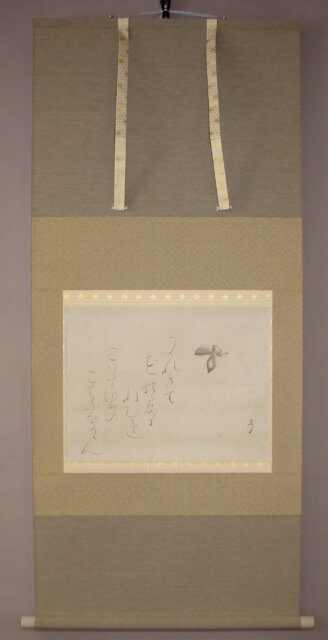An Another Kakejiku Hanging Sroll Restoration Order from a Gallery in Germany
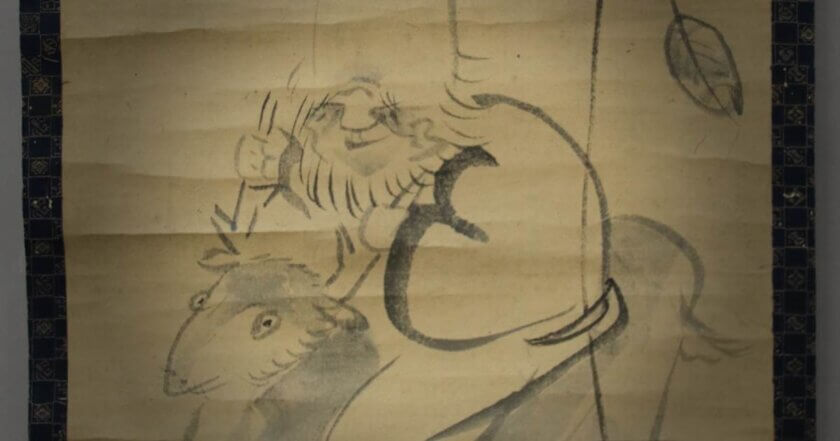
An Another Kakejiku Restoration Order from a Gallery in Germany
We take requests in regards to kakejiku internationally.
Now that I look back, I’ve been promoting kakejiku among foreign nations to raise their awareness of the charm of the artifact going through trial and error for the last 10 years or so.
Gradually, the number of the customer who makes an order or a purchase from us has been increasing.
I’m pleased with the fact that the number of customers who make another request or purchase also slowly but surely rising. I’m fairly good about remembering the episode of each customer so contact from a customer after a long while let me step back in time when I dealt with the customer with excitement.
Here is one of those episodes which is about a repeat order from a German customer.
Contents
An Another Kakejiku Restoration Order from a Gallery in Germany
This time, we received an inquiry concerning restoration for two kakejikus from an owner of a gallery in Germany mainly dealing with Japanese art treasures.
He is not a first-timer, in fact, we took a restoration work order from him previous to this occasion. You can access the story here.
Even after the completion of the restoration, we have kept in touch with each other following our own SNS mutually, updating the information.
During our exchange, he mentioned that the restored kakejiku has been obviously on the sale but even so, he has been torn if he keeps it for his private collection as he personally finds it irresistible. He is pleased by the outcome of our restoration that much which is something to be glad about.
It’s a common story among art dealers that without noticing, an item becomes not for sale by the owner of a gallery who was swept off their feet by it. Lol.
The kakejiku below is the one we were consulted with.
Sengai Gibon ‘The Lucky God Jurōjin Riding on a Deer’
Sengai Gibon (1750-1837) was an artist-Zen priest of the Rinzai school in the Edo period being well known for his paintings full of Zen feel. Born in Gifu prefecture and at a tender age, became a priest at the Seitai-ji temple in Mino city. Later in his life, he practiced Zen at temples in various districts and around 1790, became the 23rd chief priest of the Shōfuku-ji temple in Hakata. The artist who excelled at paintings and calligraphic works, especially those of ink paintings like haiga (simple painting praising haiku poetry), won popularity by his fun-loving painting style. Not until in his late forties did he allegedly begin painting in good earnest. His paintings caught on during his lifetime to such an extent that requests for his work were unstoppable. When he turned 83 years of age, he made a ‘putting down the brush declaration’, building a ‘Monument of the last work’ in his garden. Nevertheless, he ended up carrying on producing his work and even left some of those in the year of his death.

Numerous unsightly folds were found. The state with this many folds requires an urgent fix as they could result in tears.
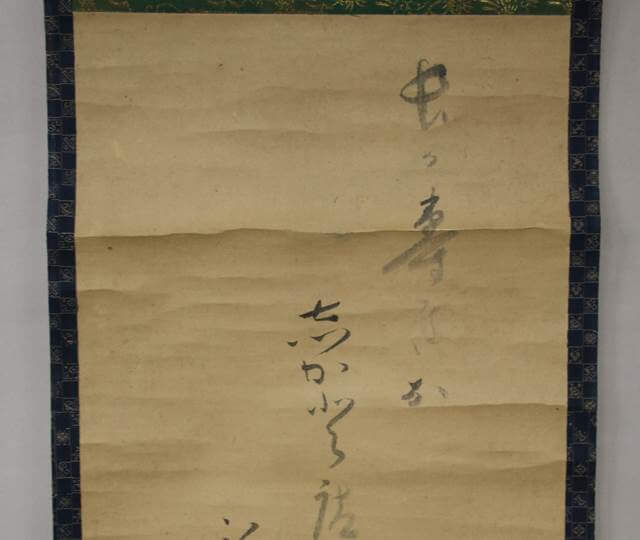
The motif is one of the Seven Gods of Good Fortune Jurōjin who is said to be accompanied by a deer. The God on the back of the deer is here painted with a fluent brushstroke.
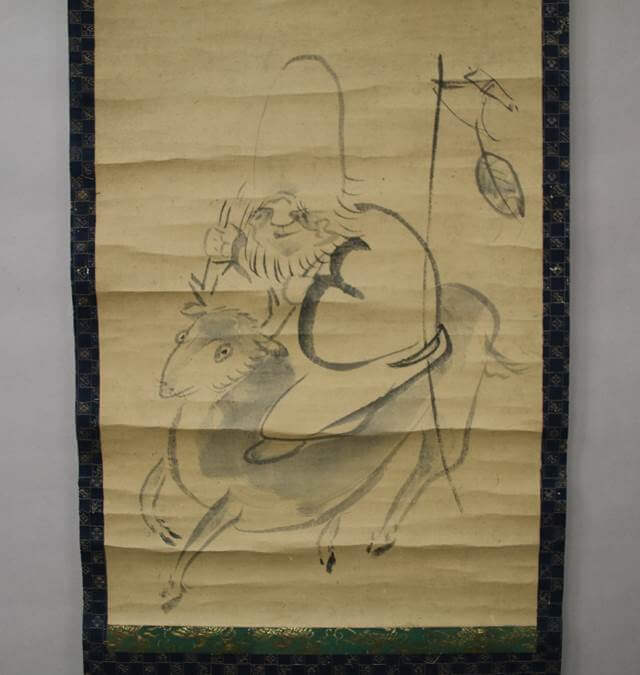
Ōtagaki Rengetsu ‘Butterfly’
Ōtagaki Rengetsu (1791-1875) was a Buddhist nun, a waka poet as well as a prolific potter who lived during the late Edo period. Born in Kyoto city, into a family of the chief retainer of Iga Ueno, Tōdō Domain yet after the loss of her parents at a young age, she was adopted by Ōtagaki Teruhisa the chief priest of the Chion-in temple in Kyoto city. She married an adopted son of the family Ōtagaki Mochihisa and had a son and two daughters but they both died young. Following Mochihisa’s death widowed her at 25 years of age. Around 4 years later, she remarried to Ōtagaki Hisatoshi who had entered the Ōtagaki family and was blessed with a daughter but she experienced yet another loss of her husband in 4 years’ time. After her second husband’s funeral, she became a nun at the Chion-in taking the tonsure, accompanied by her foster father, and took the Buddhist sobriquet Rengetsu / Lotus Moon.
After 2 years of her becoming a nun, her daughter passed away at the age of 7 that was followed by her foster father’s death when she was 42 years old. After all those years, she moved from place to place and produced her teapots and cups for living. While she was spending those days, her work was steadily becoming recognized, and naturally, people began to call her ceramic work, inscribed with her waka poem and growing in popularity ‘Rengetsu ware’. Not limited to being well known as a nun cum waka poet – the disciple of Chigusa Arikoto, she had a gift for other fields of art including tea ceremony and flower arrangement.
Besides, she fostered Tomioka Tessai while being his master and she was also the one who brought out his artistic taste during the time they lived together around 1857 onwards.
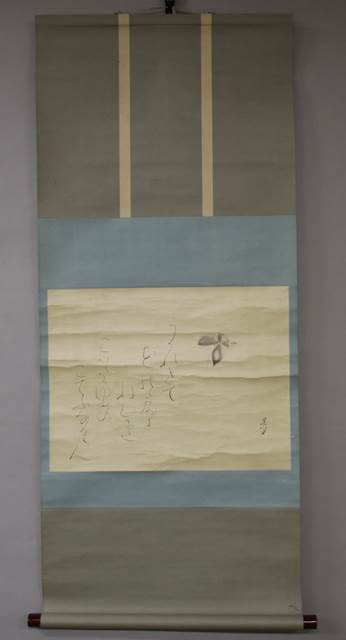
This kakejiku too was suffered from hideous folds. The fragile and flowy brushstroke was sadly disrupted.
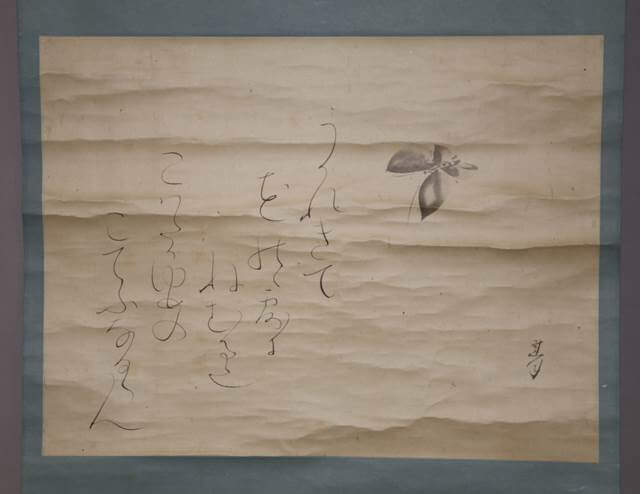
Detailed Arrangement
Although it’s difficult to spot them by the photos, both artworks had unclean parts and that was another concern for the customer.
He accepted that the cleaning and stain removal for the piece will be performed only to the extent that the process will not risk the severely damaged artwork.
As for the Jurōjin one, it’s going to be remounted by the following method.

Fabrics similar to the currently used ones were in favor with him. The piece is to be mounted without changing its mounting format, ‘Sō-no-gyō’.

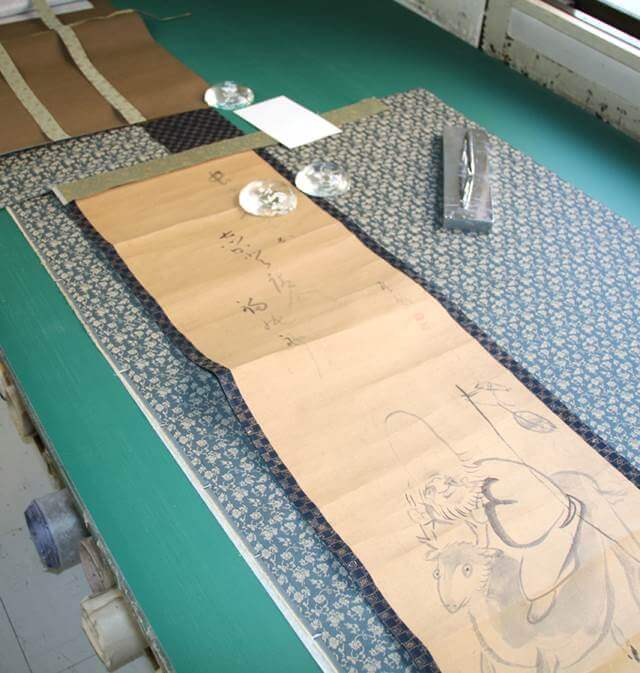
As too many folds were formed on the artwork, I recommended him to store the piece utilizing a tool called ‘Futomaki’ which can be optionally purchased.
Apart from that, what we carried on for the order was atypical. The lid of the paulownia box originally belonged to the kakejiku held loads of information.
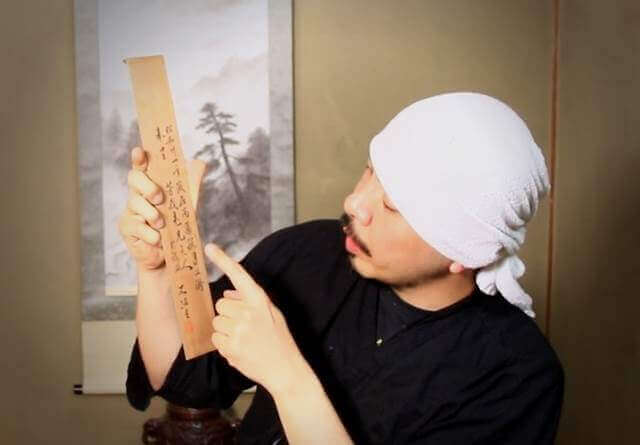
Our work on this occasion was rather unique. We’d be better off saving this written information as it’s vital for the evaluation so we undertook the renewal of the paulownia box keeping the information yet still, meeting a futomaki specification. This case was pretty rare so I wrote an article revealing all about it. Please check this out for your information.
Here is the style of mounting we settled on for the artwork of Ōtagaki Rengetsu.
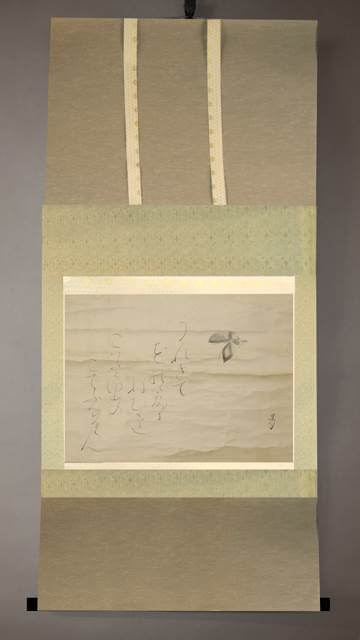
I coordinated the fabrics in soft shades of color. I selected those colors similar to the one seen in the artwork’s background aiming at an impression of the butterfly fluttering about freely in the sky which was opened out by being blended with the color of the fabrics. – Frankly, we mounters consider this and that at the decision making of mounting fabrics and take way too long time for the decision. Lol.
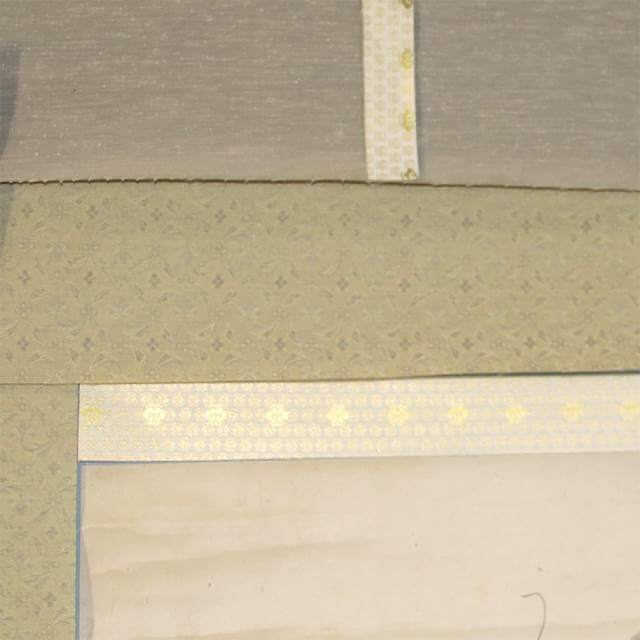
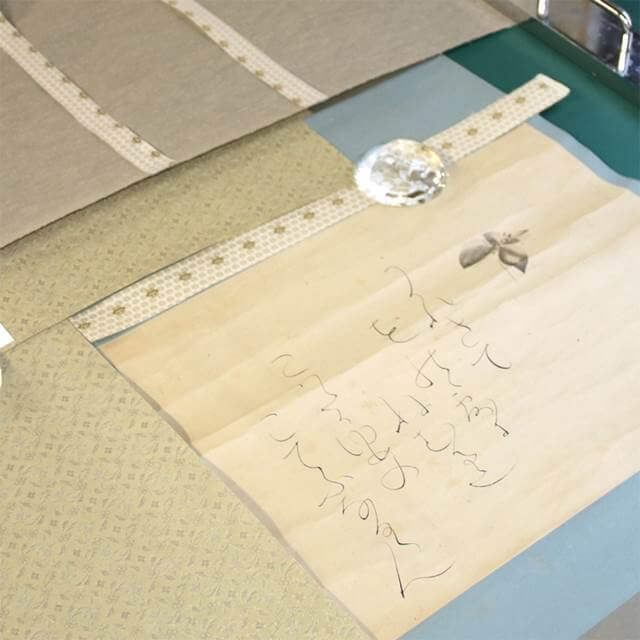
The customer originally had ‘maru mounting’ the format of mounting in mind, but we dared to suggest another style ‘gyō-no-gyō’.
Although the simply designed maru mounting has its charm, ‘gyō-no-gyō’ style which has 3 parts all playing a different role named ‘Tenchi (top and bottom)’, ‘Naka-mawashi (inner enclosure)’ and ‘Ichimonji (fabric attached above and below the main artwork)’ will enhance the attractiveness of an artwork.
Please refer to the illustration below for the names of kakejiku parts.
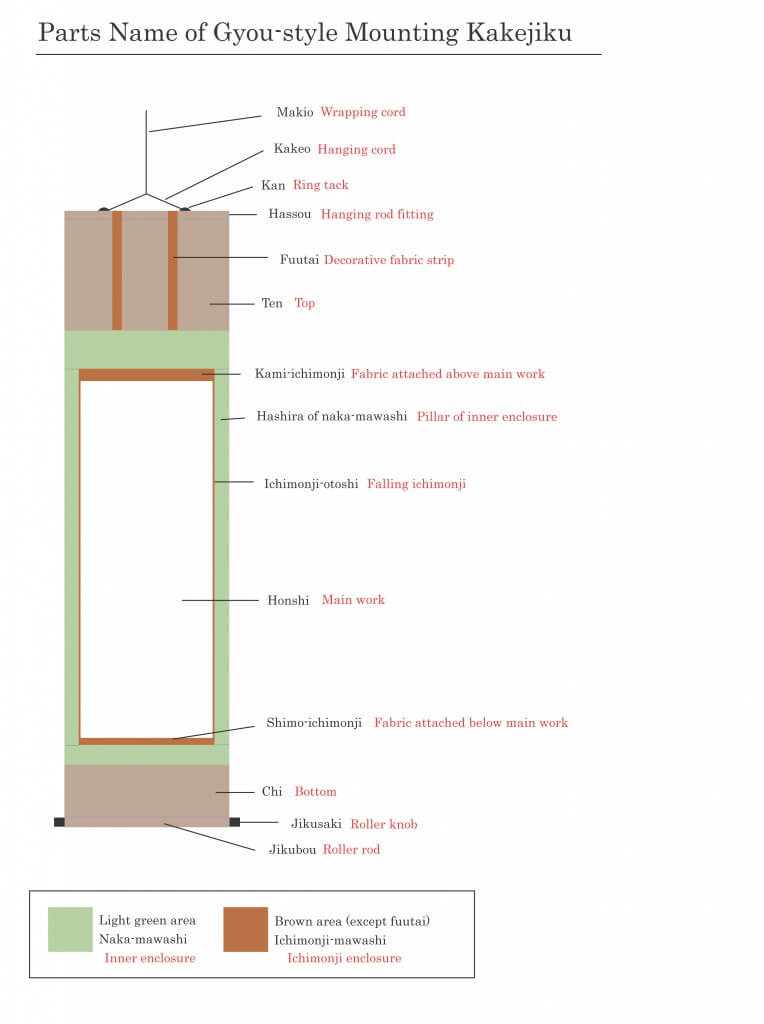
The decision falls on the customer to make, even so, I gave him a detailed explanation of the ‘gyō-no-gyō’ style, believing the choice should be made after he is fully clear about the characteristic of the style.
Our suggestion made him impressed enough to make up his mind to go for ‘gyō-no-gyō’ style.
Here we go, the details of each remounting have been decided so we can kick off the procedure.
Restoration Process of the Kakejiku
A broad process of the remounting work is shown below.
Dismantling the kakejiku – Remove the old fabric / detach the rod etc.
↓
Removing the old backing paper – A jargon for the procedure is ‘mekuru’.
↓
Cleaning the artwork – Dirt removal
↓
Removing stains – Stain removal for stains that still remained after the cleaning
↓
The first backing – Reinforcement of the artwork by pasting a piece of Japanese paper on the reverse side
↓
Ore-fuse reinforcement – Application of a thin strip of Japanese paper onto the severe crease from the back of the artwork
↓
Remounting
Completion of the Restoration and Remounting
Having gone through the lengthy restoration process, at last, the remounting of the two kakejikus has been brought to completion.
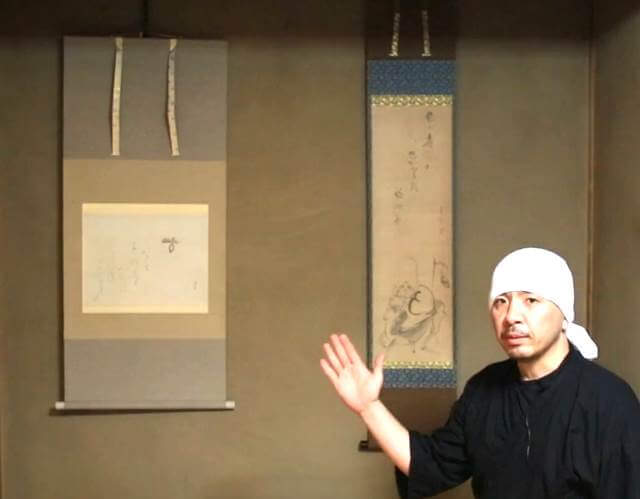
The naka-mawashi in blue is adding tastefulness to the Jurōjin artwork.
The hideous creases in its original state were such a distraction when looking at the piece. The artwork is probably torn by its own worsen folds before long if left the state untouched.
The kakejiku has come alive regaining the stunning look by the appropriate maintenance.
The kakejiku painted by Rengetsu has been also reborn beautifully. Not only did the delicate calligraphy suffer the harsh creases, but the life of the butterfly painted in pale ink too was also taken by them. Nevertheless, the kakejiku has been revived flawlessly.
The butterfly in ink now seems as if it’s fluttering about in the air spreading its wings, enjoying the freedom by surrounded with the fabric of naka-mawashi in subtle color. The gold brocade fabrics between the main artwork and the naka-mawashi are functioning as an accent dividing the color of the artwork and fabric. The parts are to be neither too eye-catching nor too discreet that requires a sensitive balance and where the aesthetic sense of a mounter is tested the most.
We straightway sent the finished pieces to the customer staying in Italy at the time.
We received a mail from him which was overwhelmed with his gratitude at the same time the pieces were delivered.
At the last weekend, the scrolls arrived me safely in Italy and I want to let you know, that I am very lucky again to receive them.
The new mountings do look fantastic and fit very well to the painting.
The Rengetsu work looks so elegant and refined with the subtle colors of the mounting and the energetic Sengai painting makes even more fun to look at with the bold colors around it.
You did a great job again. I can just imagine what a hard nerve-racking work it must been to restore the Sengai scroll with the serious wrinkles.
The futo-maki was a very good suggestion and I also like the the lid from the old box inserted into the new one. It is perfect!
Thank you so much again.
I’m absolutely pleased that he is delighted with the completed kakejikus.
Futomaki and a partial replacement of the lid of the paulownia box were also much appreciated and that made my suggestion worthwhile.
It was such a struggle explaining the partial replacement of the lid in English as he was the first foreign customer who had the work done but now I’m very glad to see his contented comment.
We take requests regarding kakejiku internationally like the episode this time.
Please feel free to contact us if you have any inquiries concerning a damage restoration or remounting of your kakejiku.




